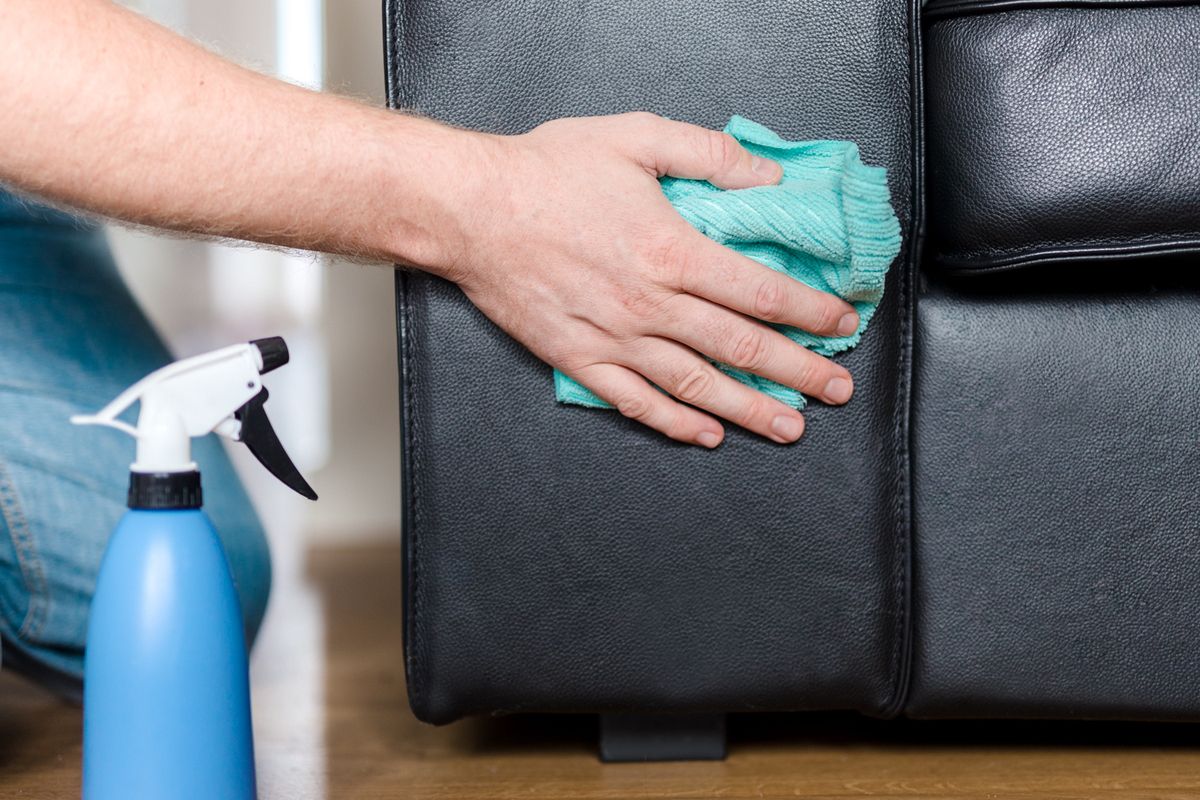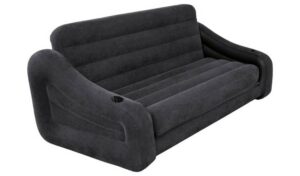A leather sofa is a luxurious and elegant addition to any home. It exudes style and sophistication, but it also requires proper care and maintenance to retain its beauty and longevity. Regular cleaning is essential to keep your leather sofa looking its best and to prevent dirt, stains, and damage from ruining its appearance. In this article, we will explore the step-by-step process of cleaning a leather sofa, along with valuable insights and expert tips to help you maintain and preserve your investment.
Understanding Different Types of Leather
Before diving into the cleaning process, it’s crucial to understand that not all leather is created equal. There are various types of leather used in furniture, each with its own characteristics and cleaning requirements. The most common types of leather used in sofas include:
- Aniline Leather: This type of leather is the most natural and luxurious. It has a soft, natural look and is highly susceptible to stains and fading. Aniline leather requires delicate cleaning methods to avoid damaging its surface.
- Semi-Aniline Leather: Similar to aniline leather, semi-aniline leather has a natural appearance but is slightly more resistant to stains. It undergoes a light surface treatment, making it easier to clean without compromising its natural beauty.
- Pigmented Leather: Pigmented leather is coated with a protective layer, making it more resistant to stains and fading. It has a uniform color and a slightly less natural appearance compared to aniline or semi-aniline leather. Cleaning pigmented leather is relatively easier.
- Top Grain Leather: This type of leather is made from the top layer of the hide and is one of the most durable options. Top grain leather is often pigmented or semi-aniline and is suitable for households with children or pets.
- Full Grain Leather: Full grain leather is the highest quality leather available. It is made from the complete grain, including the top layer with all its imperfections. It is exceptionally durable and develops a beautiful patina over time. Cleaning full grain leather requires gentle methods to avoid damaging its surface.
Gather the Necessary Cleaning Supplies
Before you begin cleaning your leather sofa, make sure you have all the necessary supplies at hand. Using the wrong cleaning products can damage the leather, so it’s important to choose the right ones. Here’s a list of supplies you’ll need:
- Soft microfiber cloths or sponges
- Leather cleaner (specifically formulated for your type of leather)
- Distilled water
- White vinegar
- Moisturizing leather conditioner
- Soft-bristled brush or toothbrush
Step-by-Step Guide to Cleaning a Leather Sofa
Now that you have your supplies ready, let’s dive into the step-by-step process of cleaning a leather sofa:
Step 1: Read the Manufacturer’s Instructions
Start by checking the manufacturer’s instructions for your specific leather sofa. Some manufacturers may provide specific cleaning guidelines or recommend certain products to use or avoid. Following these instructions will help you prevent any damage to your sofa and ensure you clean it correctly.
Step 2: Test the Cleaning Product
Before applying any cleaning product to your leather sofa, it’s essential to perform a spot test in an inconspicuous area. This will help you determine if the product causes any discoloration or damage to the leather. Apply a small amount of the cleaner on a hidden part of the sofa and wait for a few minutes. If there are no adverse effects, you can proceed with the cleaning process.
Step 3: Remove Loose Dirt and Dust
Using a soft microfiber cloth or a vacuum cleaner with a brush attachment, gently remove any loose dirt, dust, or debris from the surface of the sofa. Pay attention to the crevices and corners where dirt tends to accumulate. This step will prevent scratching the leather during the cleaning process.
Step 4: Prepare the Cleaning Solution
If your leather sofa is heavily soiled or stained, you may need to prepare a cleaning solution. Mix a few drops of a mild leather cleaner (specifically formulated for your type of leather) with distilled water in a spray bottle. Avoid using harsh chemicals, such as bleach or ammonia, as they can damage the leather surface.
Step 5: Clean the Leather Surface
Spray the cleaning solution onto a soft microfiber cloth or sponge, and gently wipe the leather surface in circular motions. Avoid applying too much pressure, as it can push the dirt further into the leather or cause damage. Work on small sections at a time and ensure even coverage.
Step 6: Address Stains and Spills
If you encounter stains or spills on your leather sofa, it’s crucial to act quickly. Blot the stain with a clean, damp cloth as soon as possible to prevent it from setting into the leather. Avoid rubbing the stain, as it can spread and make the situation worse. If the stain persists, consult a professional leather cleaner for advice.
Step 7: Rinse the Leather Surface
After cleaning the leather surface, dampen a clean cloth with distilled water and gently wipe off any remaining cleaning solution. This step will help remove any residue and prevent it from drying on the leather.
Step 8: Dry the Leather Sofa
Allow the leather sofa to air dry naturally. Avoid using a hairdryer or placing the sofa in direct sunlight, as excessive heat can cause the leather to crack or fade. Patience is key during this step, as rushing the drying process can lead to damage.
Step 9: Apply a Leather Conditioner
Once the leather sofa is completely dry, apply a high-quality leather conditioner to restore moisture and prevent cracking. Use a soft microfiber cloth or sponge to apply the conditioner in gentle, circular motions. Follow the manufacturer’s instructions for the specific leather conditioner you’re using.
Step 10: Buff and Polish the Leather
After applying the leather conditioner, use a clean, dry microfiber cloth to buff and polish the leather surface. This step will help enhance its shine and bring out its natural beauty.
Tips for Maintaining a Leather Sofa
Cleaning your leather sofa is just one part of the equation. To ensure its longevity and preserve its appearance, here are some additional tips for maintaining your leather sofa:
- Keep your leather sofa away from direct sunlight or heat sources, as they can cause the leather to fade or crack.
- Regularly dust and vacuum your leather sofa to prevent dirt and debris from settling into the leather pores.
- Wipe up spills immediately to prevent them from staining the leather.
- Avoid using abrasive or harsh cleaning products on your leather sofa, as they can damage the surface.
- Use leather protectors or conditioners regularly to maintain the leather’s suppleness and prevent drying.
Conclusion
Cleaning a leather sofa may seem like a daunting task, but with the right knowledge and tools, it can be a straightforward process. By understanding the type of leather you have and following the proper cleaning steps, you can keep your leather sofa looking pristine for years to come. Remember to regularly maintain and protect your leather sofa to extend its lifespan and preserve its elegance. With proper care, your leather sofa will continue to be a centerpiece of beauty and comfort in your home.
FAQs After The Conclusion
1. Can I use regular household cleaners to clean my leather sofa?
No, it’s not recommended to use regular household cleaners on your leather sofa. They can be too harsh and can cause damage to the leather. It’s best to use cleaners specifically formulated for leather.
2. How often should I clean my leather sofa?
The frequency of cleaning your leather sofa depends on its use and exposure to dirt. As a general guideline, it’s recommended to clean your leather sofa every 6-12 months to prevent dirt buildup and maintain its appearance.
3. Can I use water to clean my leather sofa?
Yes, you can use water to clean your leather sofa, but it’s essential to use distilled water to avoid mineral deposits. Additionally, make sure to spot test the water on an inconspicuous area before applying it to the entire sofa.
4. How do I remove ink stains from my leather sofa?
Ink stains can be challenging to remove from leather. It’s best to consult a professional leather cleaner for advice on removing ink stains without causing further damage to the leather.
5. What should I do if my leather sofa gets scratched?
If your leather sofa gets scratched, you can try using a leather conditioner or a specialized leather repair kit to minimize the appearance of the scratch. If the scratch is deep or extensive, it’s recommended to seek professional help for repair.
Key Takeaways> > – Cleaning a leather sofa requires proper understanding of the type of leather and its specific cleaning requirements.> – Gather all the necessary cleaning supplies, including a soft cloth or sponge, leather cleaner, distilled water, white vinegar, and a leather conditioner.> – Follow a step-by-step process, including reading the manufacturer’s instructions, spot testing the cleaning product, removing loose dirt and dust, preparing the cleaning solution, cleaning the leather surface, addressing stains and spills, rinsing the leather surface, drying the sofa, applying a leather conditioner, and buffing and polishing the leather.> – Maintain your leather sofa by keeping it away from direct sunlight and heat sources, regularly dusting and vacuuming, promptly wiping up spills, avoiding harsh cleaning products, and using leather protectors or conditioners.> > Cleaning and maintaining a leather sofa may seem like a daunting task, but with proper knowledge and care, you can ensure its longevity and preserve its elegant appearance. By understanding the type of leather you have and following the recommended cleaning steps, you can keep your leather sofa looking pristine for years to come. Take the time to regularly maintain and protect your leather sofa, and it will continue to be a centerpiece of beauty and comfort in your home.> > Whether you have an aniline, semi-aniline, pigmented, top grain, or full grain leather sofa, the cleaning process remains relatively similar. However, it’s crucial to consider the specific cleaning requirements of your type of leather. Following the manufacturer’s instructions is essential to prevent any damage and preserve the warranty of your sofa.> > So, gather your cleaning supplies and start the process by removing loose dirt and dust from the surface of your leather sofa. Prepare a cleaning solution using a mild leather cleaner and distilled water. Test the solution in an inconspicuous area to ensure it doesn’t cause any discoloration or damage. Once confirmed, proceed to clean the leather surface using a soft cloth or sponge, working on small sections at a time.> > In case of stains or spills, blot them immediately with a clean, damp cloth. Avoid rubbing the stain, as it can spread and make it more difficult to remove. If the stain persists, consult a professional leather cleaner for advice.> > After cleaning the leather surface, rinse it with a clean cloth dampened with distilled water to remove any residue. Allow the sofa to air dry naturally, avoiding direct sunlight or heat sources that can cause the leather to crack or fade. Once dry, apply a leather conditioner to restore moisture and prevent drying and cracking. Buff and polish the leather surface with a clean, dry cloth to enhance its shine and bring out its natural beauty.> > To maintain your leather sofa’s longevity, ensure you follow some essential tips. Keep it away from direct sunlight and heat sources, as they can cause fading and damage. Regularly dust and vacuum the sofa to prevent dirt and debris from settling into the leather pores. Immediately wipe up any spills to prevent them from staining the leather. Avoid using harsh or abrasive cleaning products that can damage the surface. Finally, use leather protectors or conditioners regularly to maintain the leather’s suppleness and prevent drying.> > With proper care and maintenance, your leather sofa will continue to be a focal point of elegance and comfort in your home for many years to come. Take the time to clean it regularly, follow the recommended guidelines, and enjoy the lasting beauty of your leather sofa.> >
FAQs
> >
1. Can I use regular household cleaners to clean my leather sofa?
> > No, it’s not recommended to use regular household cleaners on your leather sofa. They can be too harsh and can cause damage to the leather. It’s best to use cleaners specifically formulated for leather.> >
2. How often should I clean my leather sofa?
> > The frequency of cleaning your leather sofa depends on its use and exposure to dirt. As a general guideline, it’s recommended to clean your leather sofa every 6-12 months to prevent dirt buildup and maintain its appearance.> >
3. Can I use water to clean my leather sofa?
> > Yes, you can use water to clean your leather sofa, but it’s essential to use distilled water to avoid mineral deposits. Additionally, make sure to spot test the water on an inconspicuous area before applying it to the entire sofa.> >
4. How do I remove ink stains from my leather sofa?
> > Ink stains can be challenging to remove from leather. It’s best to consult a professional leather cleaner for advice on removing ink stains without causing further damage to the leather.> >
5. What should I do if my leather sofa gets scratched?
> > If your leather sofa gets scratched, you can try using a leather conditioner or a specialized leather repair kit to minimize the appearance of the scratch. If the scratch is deep or extensive, it’s recommended to seek professional help for repair.





